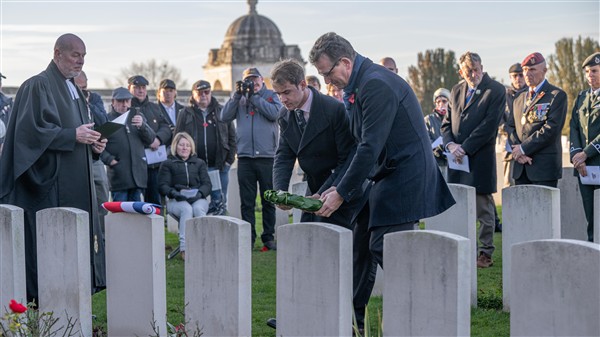On Wednesday, 12 November 2025, at 9:00 a.m., a ceremony was held at the British Tyne Cot Cemetery in Passchendaele. Lieutenant Norman Frederick Hunter was given a new gravestone bearing his name, thanks to research that proved he was indeed buried there.
The service was conducted by The Reverend David Jeal CF, Chaplain to The Royal Dragoon Guards.
Lieutenant Norman Frederick Hunter

Lieutenant Norman Frederick Hunter was born on 1 March 1879 in Edinburgh, Scotland. He was one of nine children born to Dr James Adam Hunter MD and his wife Marion. Norman was educated at the Loretto School in Musselburgh before studying at Clare College Cambridge. He and his elder brother Thomas Mansfield Hunter, were keen amateur golfers at the Tantallon Golf Club, North Berwick and had played in the Open Championship. Norman had also been the captain of the Oxford and Cambrigde Golfing Society. On 17 April 1908, Norman Married Elizabeth Birrell in Fife. They lived in Huntingdon, Ascot, and Norman was the captain of the Surringdale Golf Club. He lived off his own means and was an Underwriting Member of Lloyd's Bank.
On 8 October 1914, shortly after the outbreak of the First World Ware, Norman was Commissioned as a second lieutenant into 4th Battalion The Royal Warwickshire Regiment. He was promoted to lieutenant on 24 December 1914. He arrived on the Western Front in March 1915 and was attached to 4th Battalmion The Royal Fusiliers.
On 16 June 1915, 4th Battalion The Royal Fusiliers took part on the right of an attack with 1st Battalion The Royal Scots Fusiliers in the centre and 5th Battalion The Royal Fusiliers on the left. The attack took place north of the Menin Road near Hooge. Their final objective was the edge of Bellewaerde Lake. At 02:50 hours a prepatory bombardment started. This lasted until 04:15 hours when the attack commenced. The first line of German trenches was taken but the men were so eager to move forward that they moved too fast and pushed ahead to the second and third German lines only to be mown down by their own artillery.
Having lost a number of Officers and men they withdrew to a communication trench and consolidated this into a fire trench and held off counter attacks. They were ordered to leave the trench and go into the woods that had just been captured to support the men who remained there. These men had been shelled all day, and their casualities were heavy.
Having been wounded in the leg and foot during the attack Lieutenant Hunter was carried to safety in a dugout. When the battalion retired, he was left behind. A Private Riley stated that he had stayed with Lieutenant Hunter for some time and made him comfortable and 'put him in a sort of a ditch' but was eventually forced to leave him. It appears that Lieutenant Hunter must have subsequently succumbed to his wounds. He was 36 years old.
After the war the remains of Lieutenant Hunter were recovered and buried in Tyne Cot Cemetery as an unknown lieutenant of The Royal Warwickhsire Regiment. And as he was missing, Lieutenant Hunter was commemorated on the Menin Gate. However, new research has shown that this is in fact his grave and the headstone has now been replaced to reflect this. We will now remember Lieutenant Norman Frederick Hunter and his grave has been rededicated.
.jpg)
.jpg)





.jpg)
.jpg)
.jpg)

.jpg)
.jpg)
.jpg)
.jpg)
.jpg)

Page made by WO1.be / Greatwar.be - Foto's/Pictures Eric Compernolle.